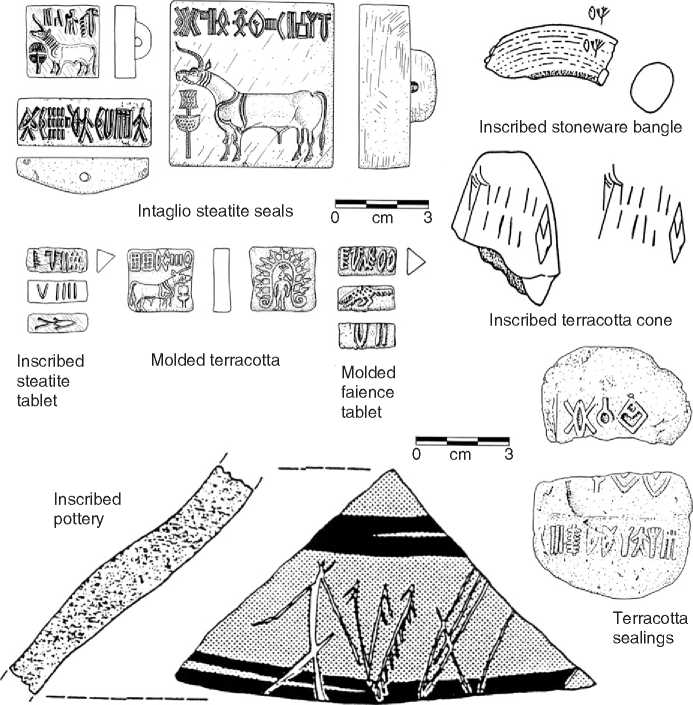During the Harappa phase, the Indus script appears to have been standardized throughout the Indus region and used in a wide variety of contexts and forms. This script emerged out of earlier forms of writing found during the Kot Diji phase at Harappa and other sites throughout the greater Indus valley region (Figure 10). Beginning around 2600-2450 BC, the most widespread context for writing is seen in cursive graffiti incised onto pottery that was used for storage and trade, as well as for personal or ritual use. Other forms of cursive script are seen on personal ornaments used to indicate ownership or dedication. The most formal type of writing is seen inscribed on square steatite seals that were also carved with animal motifs. The various iconographic motifs include the mythical unicorn, multiple headed animals, as well as the bull, elephant, bison, goat, tiger, and rhinoceros. The inscriptions were made in reverse and stamped into clay sealings to create a positive text indicating ownership or destination. Beginning around 24502200 BC, a complex system of inscribed tablets or tokens was developed for keeping accounts and maintaining trade contacts throughout the Indus valley. Toward the end of the Harappa phase, c. 22001900 BC, distinctive copper tablets with incised script and animal motifs were produced at Mohenjo-daro, and a different style of copper tablet with raised script on both sides was produced at Harappa. These copper tablets were relatively standardized in terms of shape, weight, and inscriptions, and may have been used for special accounting or rituals. During this same time period, rectangular seals with writing, but no animal motif began to be used, and writing came to be used in conjunction with elaborate narrative depictions of myths and religious ceremonies found on seals, tablets, or pendants.
The Indus script has not yet been deciphered, due to the absence of bilingual tablets and the lack of long inscriptions. More than one language may have been spoken in the Indus settlements and therefore the Indus script was probably used to write words or short sentences in more than one language. The major language families that may have coexisted in the greater Indus region include Dravidian, Austro-Asiatic, Sino-Tibetan, and Indo-Aryan. While some individuals have proposed that the Indus script was

Figure 10 Indus script and seal types.
Not a writing system and was not used to encode a language, this opinion is not widely supported.
Most inscriptions are made up of only a few signs, with the average being five signs. The contexts of its use allow archaeologists to reconstruct the function and importance of writing in the economy, politics, and ideology of the Indus cities. The script was quite versatile and could be used to encode a range of messages. The general function of the inscriptions would have been to identify ownership of goods or economic transactions, accounting, the recording of sociopolitical or ritual events and less formal graffiti. Approximately 400-450 different signs have been identified, but not all were used at the same time. The number of signs and the sequences in which they occur has led many scholars to suggest that the writing system is logo-syllabic, though some signs appear to have served as pictographs or even as ideographs. Most inscriptions were written from right to left, though some longer inscriptions were written in both directions, alternating from right to left on each succeeding line.
As noted above, the use of the Indus script and the types of objects being inscribed can now be divided into three phases corresponding to the major chronological developments at Harappa. Although there may have been some use of graffiti on pottery during the Late Harappa phase (1900-1300 BC), inscribed Indus seals were no longer made or used after around 1900 BC. The relatively abrupt disappearance of a writing system that had existed for over 700 years suggests that the Indus script itself was closely linked to the ruling elites of the Indus cities and that the writing system had economic, religious, and political significance.




 World History
World History









